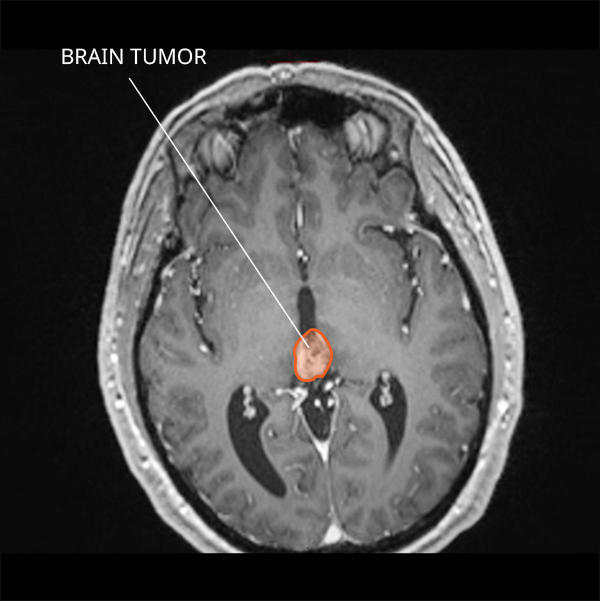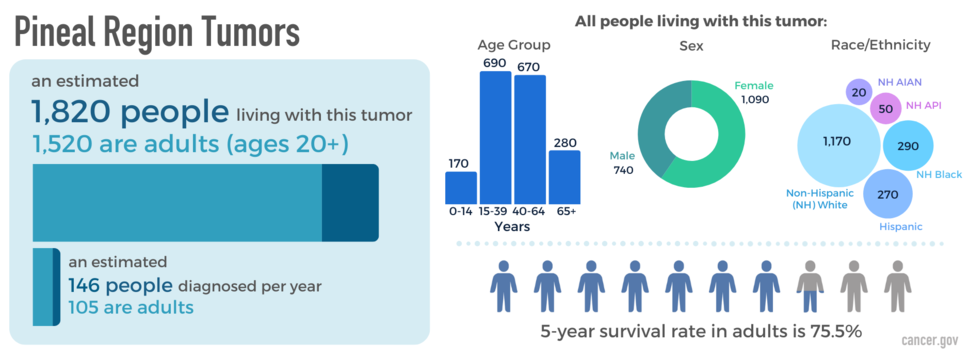Pineal region tumors are primary central nervous system (CNS) tumors. These tumors begin in the brain (in the pineal gland) but can spread to the spinal cord.
To get an accurate diagnosis, a piece of tumor tissue will be removed during surgery, if possible. A neuropathologist should then review the tumor tissue.
What Are the Grades of Pineal Region Tumors?
Primary CNS tumors are graded based on a tumor tissue analysis performed by a neuropathologist. Pineal region tumors are grouped into four grades and subtypes based on their characteristics: grade 1, 2, 3, or 4 (also written as grade I, II, III, or IV).
- Grade 1 pineocytoma are low-grade tumors. This means the tumor cells grow slowly.
- Grade 2 or 3 pineal parenchymal or papillary tumors of the pineal region are both mid-grade tumors. This means they have a higher chance of coming back after being removed.
- Grade 4 pineoblastoma are malignant (cancerous). This means they are fast-growing and tend to invade nearby tissue.
What Do Pineal Region Tumors Look like on a CT Scan or MRI?
Pineal region tumors usually appear as a solid mass that brightens with contrast on a magnetic resonance imaging (MRI) scan. On a computerized tomography (CT) scan, calcium may be present. Pineoblastomas may extend into surrounding brain structures.
What Causes Pineal Region Tumors?
Cancer is a genetic disease—that is, it is caused by certain changes to genes that control the way our cells function. Genes may be mutated (changed) in many types of cancer, which can increase the growth and spread of cancer cells. The cause of most pineal region tumors is not known. However, pineoblastomas can occur in people with the inherited genetic disorder bilateral retinoblastoma.
Where Do Pineal Region Tumors Torm?
Pineal region tumors form in the pineal region of the brain, which is located deep in the middle of the brain. Pineal region tumors arise from stem cells near the pineal gland.
Do Pineal Region Tumors Spread?
Pineal region tumors can spread to other areas in the CNS through cerebrospinal fluid (CSF).
What Are the Symptoms of a Pineal Region Tumor?
Symptoms related to pineal region tumors depend on the tumor’s location. Pineal region tumors may cause increased pressure inside the skull due to too much production of CSF or blockage of its normal flow. This problem is known as hydrocephalus
Signs and symptoms of hydrocephalus may include:
- Headaches
- Nausea
- Vomiting
- Difficulty with eye movements
- Difficulty with balance
- Difficulty walking
Who Is Diagnosed with a Pineal Region Tumor?
Pineal region tumors occur in children and young to middle-aged adults. Pineoblastomas are more common during the first 20 years of life. All tumors, except papillary tumors of the pineal region, occur slightly more often in females than males. They are most common in non-Hispanic white people. An estimated 1,820 people are living with this tumor in the United States.
What Is the Prognosis of Pineal Region Tumors?
The likely outcome of the disease or chance of recovery is called prognosis. Prognosis is based on tumor grade, location, tumor type, extent of tumor spread, genetic findings, the patient’s age, and tumor remaining after surgery (if surgery is possible).
The relative five-year survival rate for pineal region tumors is 75.5 percent. However, there are many factors that affect prognosis. These include the tumor grade and molecular type, the person’s age and health when diagnosed, and how they respond to treatment. If you want to understand your prognosis, talk to your doctor.
What Are the Treatment Options for Pineal Region Tumors?
The first treatment for pineal region tumors is surgery, if possible. The goal of surgery is to obtain tissue to determine the tumor type and remove as much tumor as possible without causing more symptoms.
Treatments after surgery may include radiation, chemotherapy, or clinical trials. Clinical trials test new chemotherapy, targeted therapy, or immunotherapy drugs. Treatments are decided by the patient’s health care team based on the patient’s age, remaining tumor after surgery, tumor type, and tumor location.
Open Clinical Studies for Pineal Region Tumors
- PLX038 in CNS Tumors
- Immune Checkpoint Inhibitor Nivolumab for Patients with Rare CNS Cancers
- ONC206 for Patients with Rare CNS Neoplasms
Learn More
- Video: Clinical Trial Tests Nivolumab for Patients with Rare Brain and Spine Cancers
- Statistical Report Highlights Key Trends in Adolescents and Young Adults with Brain Tumors
- Modifying a Chemotherapy Drug Offers Hope to People with Rare Brain and Spine Tumors
- Smart Wearables Show Promise for Tracking Sleep Patterns in Brain Tumor Patients
- Read our NCI-CONNECTions Blog for current news and information on brain and spine tumors
Referrals
NCI-CONNECT doctors and nurses work with you and your primary doctor to collaborate on a comprehensive care plan that treats your brain or spine tumor. They will also help you cope with the physical and emotional aspects of your diagnosis. Learn about requesting a consultation >



